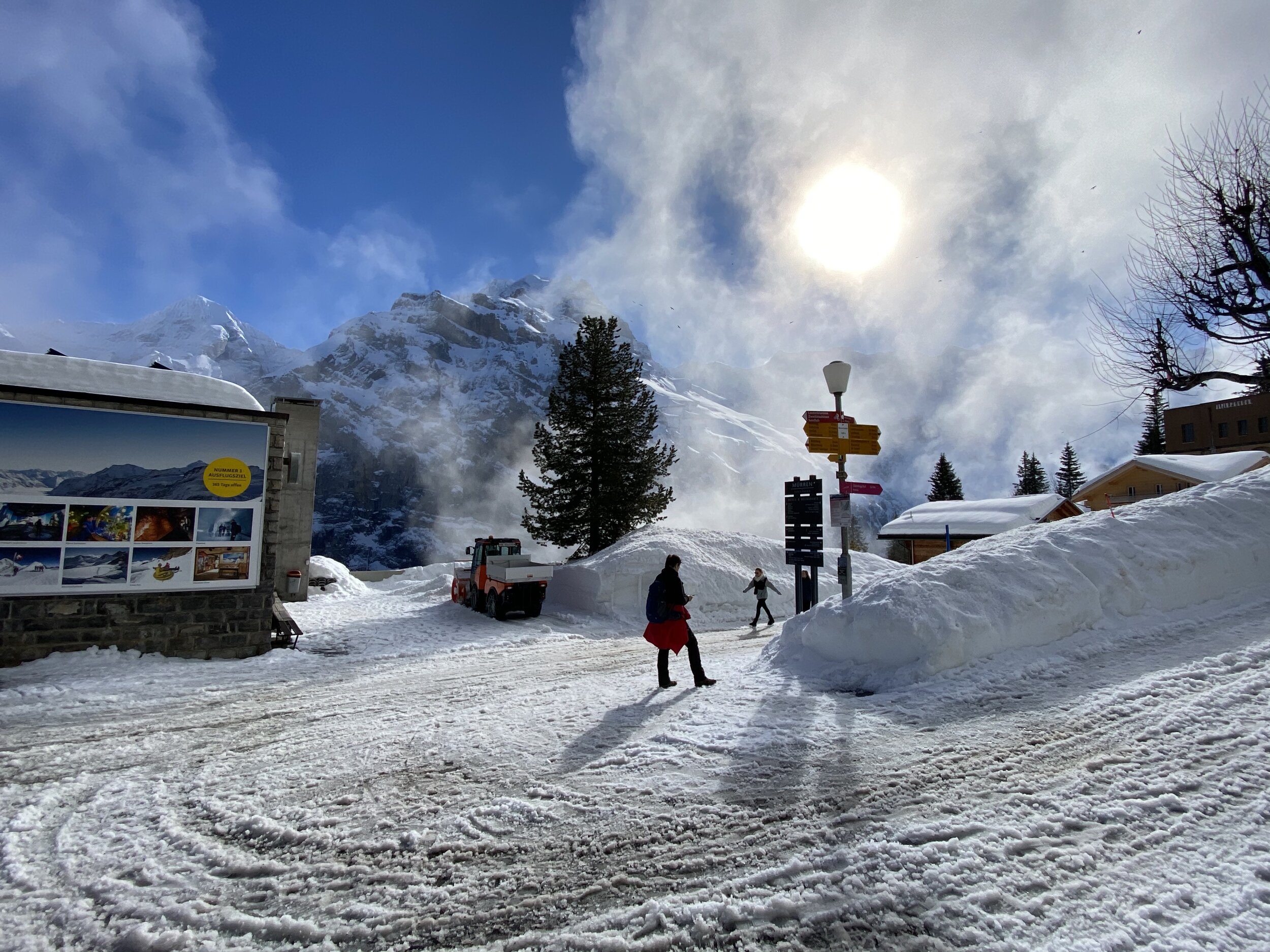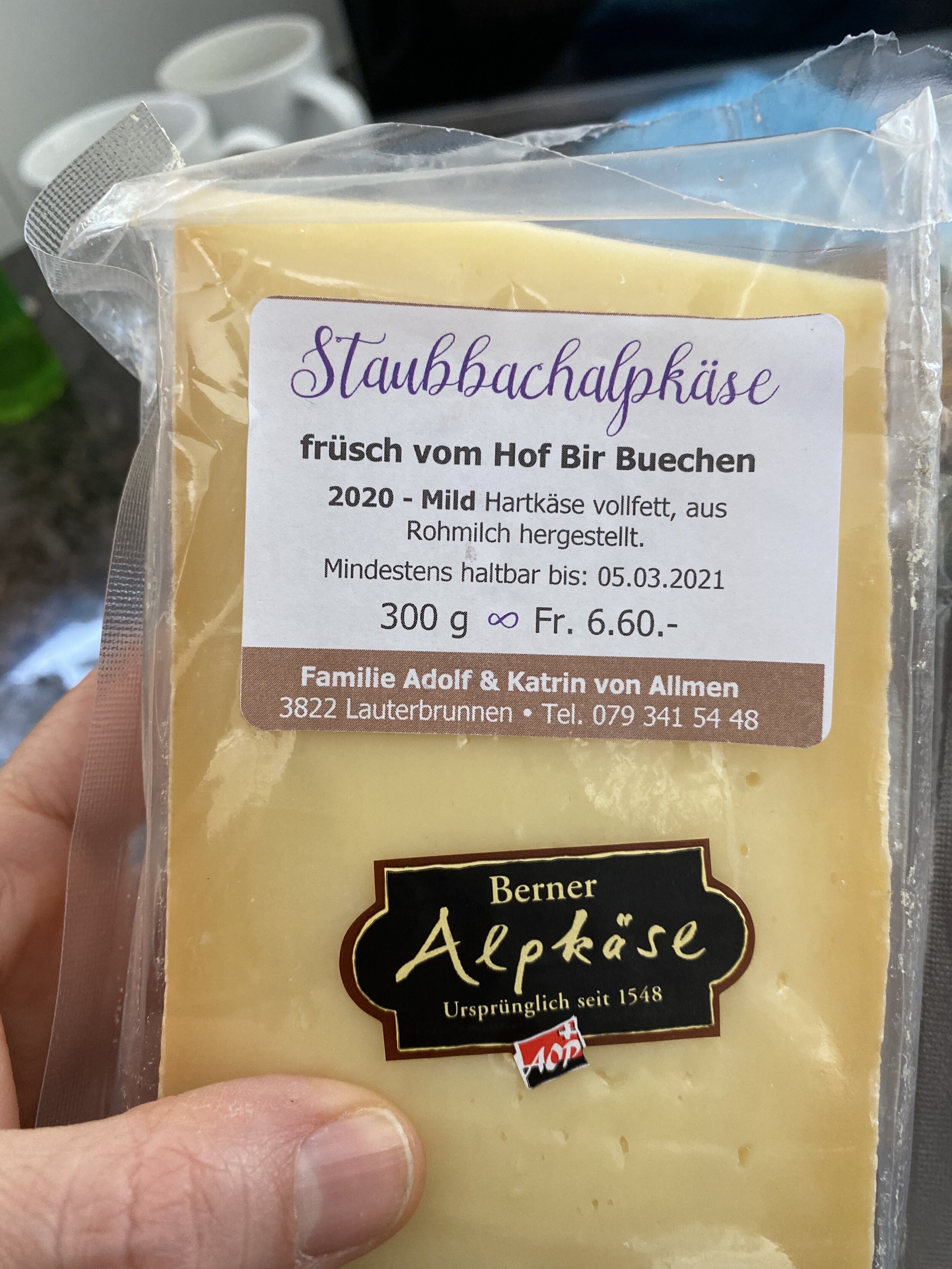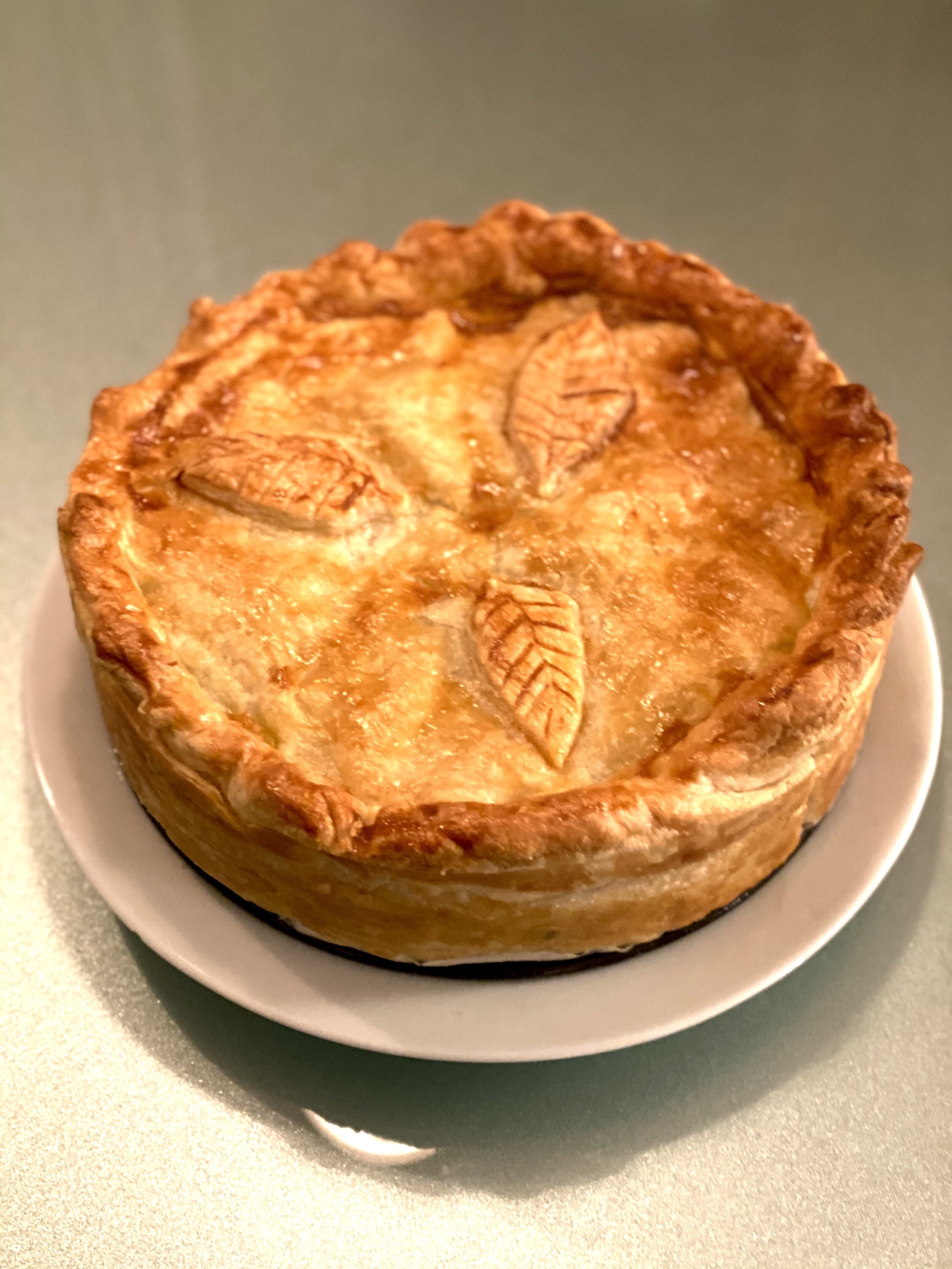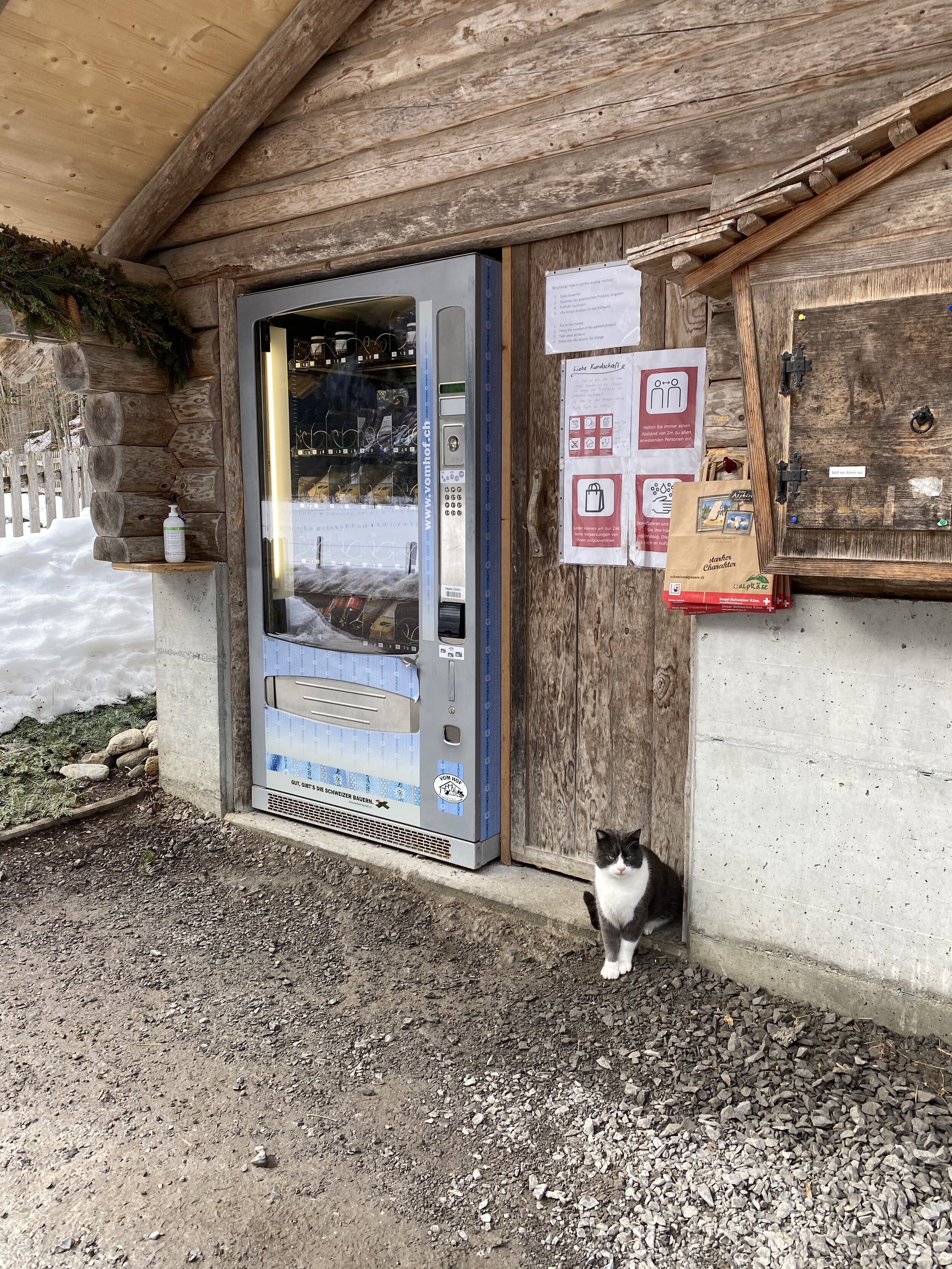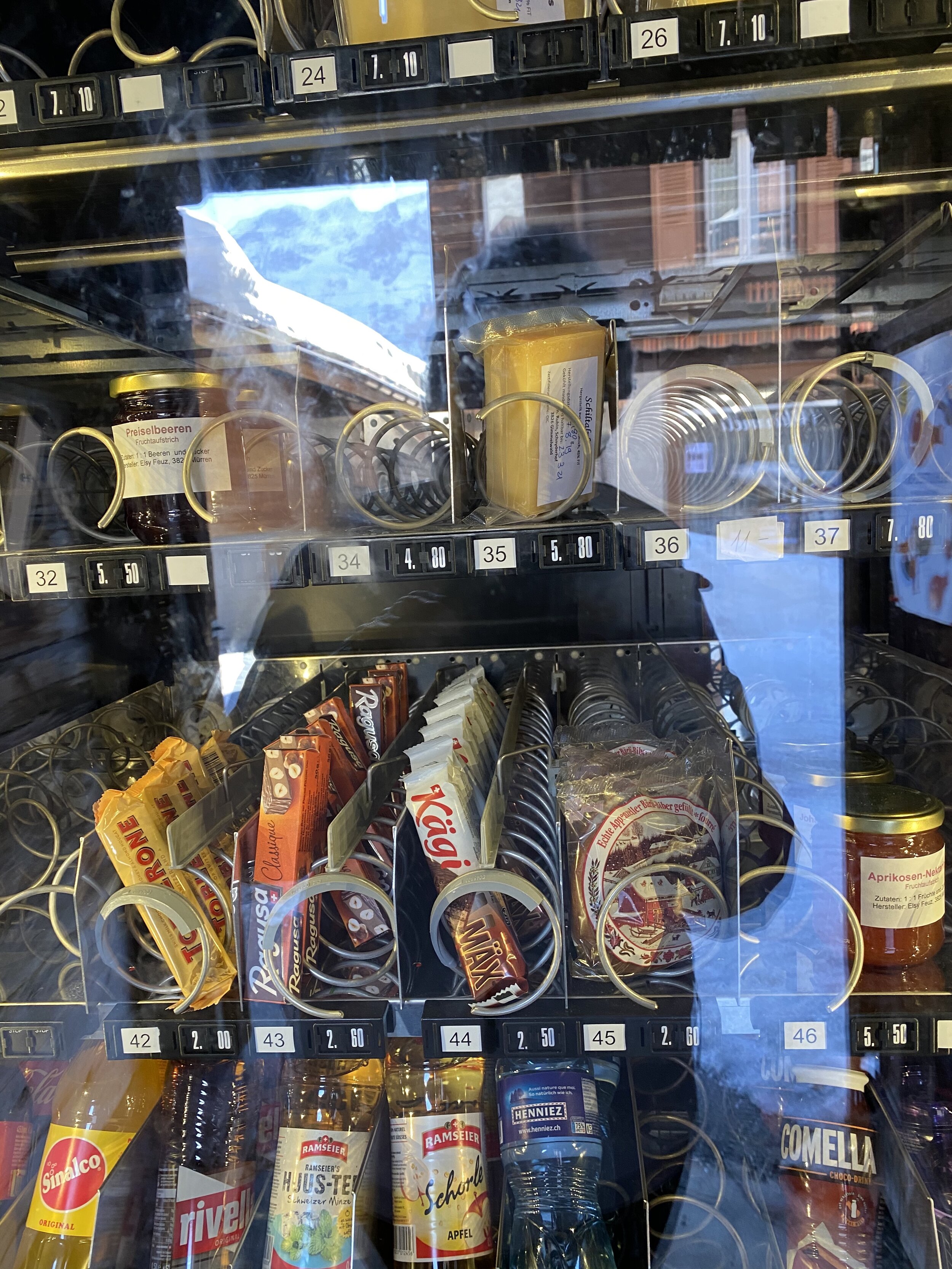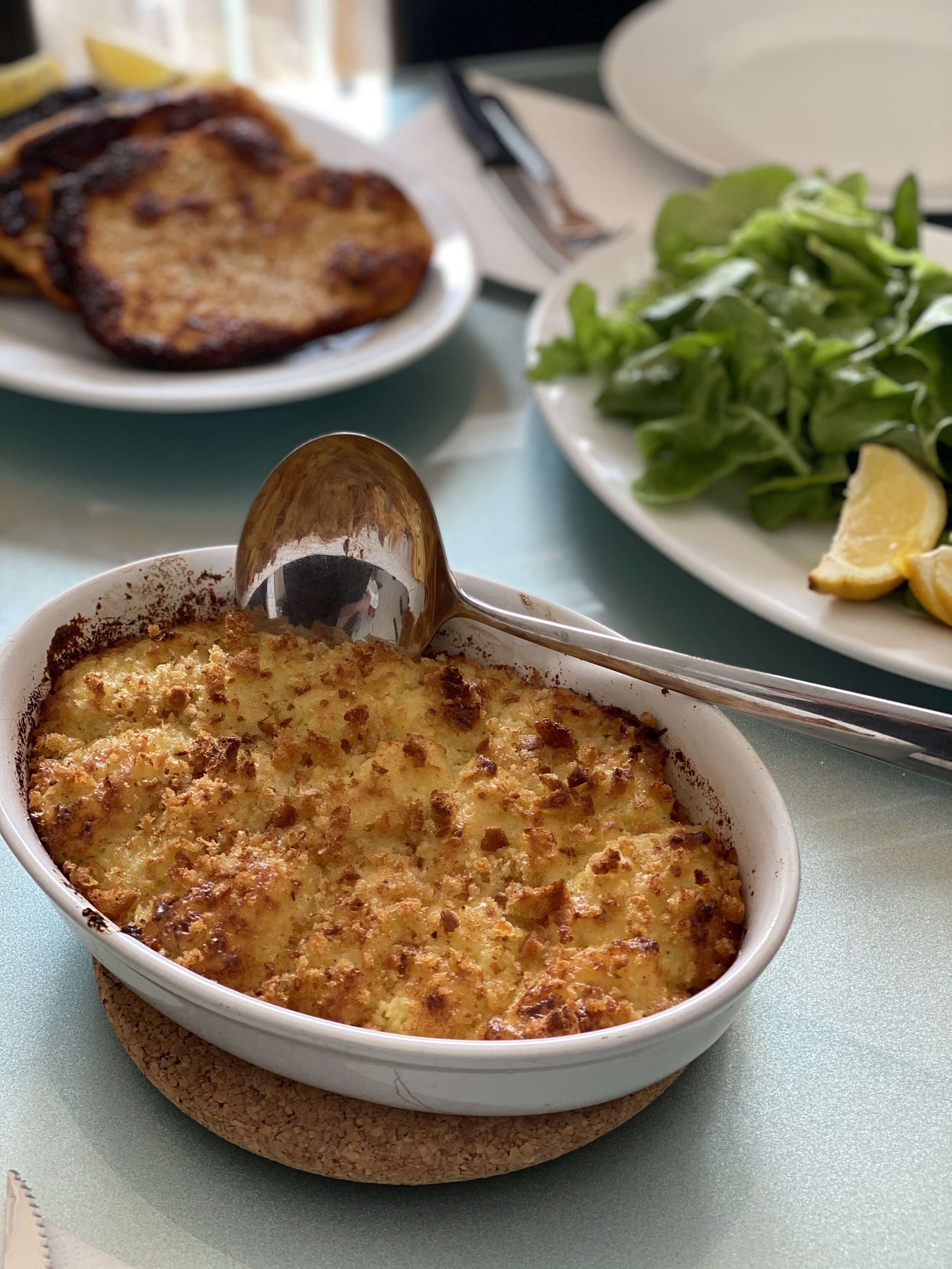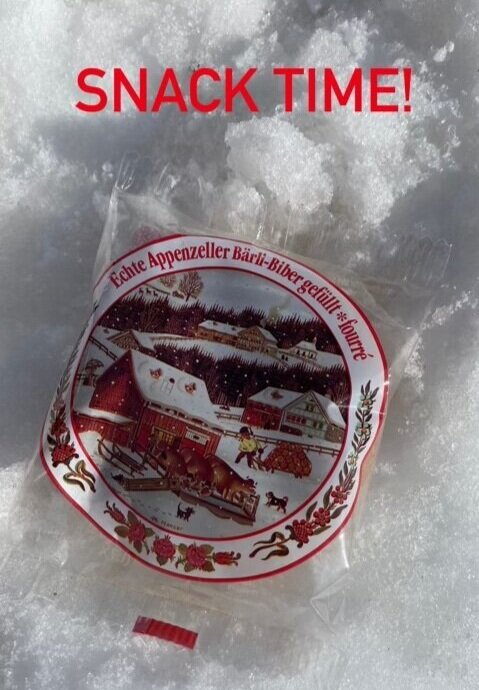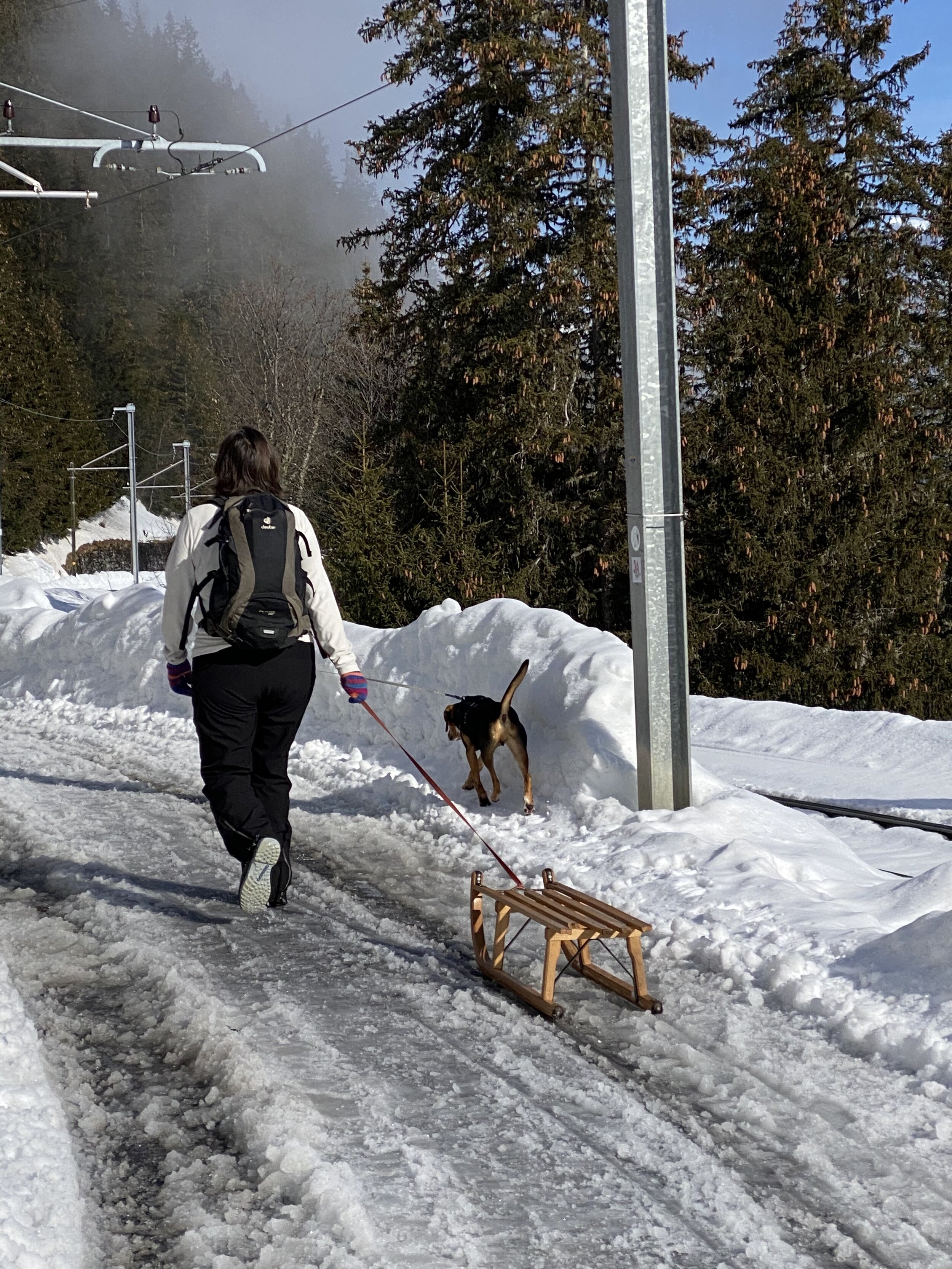Eating on Alpine Time
/Lauterbrunnen Station
The bus is quiet. Just a few people staring out the window or scrolling through their phones. I idly wonder where they’re coming from and where they’re going to as my hand rests on my shopping bag filled with pretzel buns, puff pastry, butter, and Ovalmaltine cookies. Above the bus driver, a screen illustrates the next few stops, along with their arrival times, an image of a clock ticking round in the lower right hand corner. It’s a small clock, yet it boasts a second hand. I tense slightly, seeing that slight red line swoop towards the top of the dial. As it clicks over the twelve, I feel the exhale of brakes and the bus rolls onto the village street.
After living in Italy, and in the States, I find this kind of precision fairly jaw dropping.
As the bus progresses down the road, I consider how public transport is the norm here. You can easily plot a series of bus/train/gondola rides to get you anywhere you need to be, without putting chains on your tires or stopping for a fill up. Like this bus, all the elements run like clockwork, down to the second.
Train between Winteregg and Mürren
At the next stop, I watch people climb on the bus with sleds, and I wonder how that kind of exactly precision informs a psyche. If you grow up knowing that you can step out of your house loaded down with skis to find a bus pulling up, right on time…what’s it like to learn that kind of trust? Do Swiss people develop their own internalized clocks? Without even thinking about it, can they time a goodbye or a shopping trip to coincide with a bus’s arrival? They certainly never, ever look in a hurry or the least frazzled.
I myself am so busy wondering, I almost miss getting off at the Schuzenbach stop, which is a 30 second walk from my apartment. I hitch my shopping bag over my shoulder and pat my pocket where my key is as I consider further…
Is it possible that this kind of carefully crafted counting not only impacts the psychology of a people, but can it also be an outgrowth that people’s history of adapting to their environment?
Here’s what I mean. If a bus is late here, if it doesn’t show up, people are waiting in sub-zero temperatures. Switzerland is gorgeous, but in a kind of forbidding way, what with those towering cliffs and the crackle of falling ice and the tops of mountains that don’t curve so much as grind against the early dawn sky.
In Italy, I’ve watched an entire brass band in Alberobello wait patiently while their leader finished his cigarette, which he didn’t seem inclined to rush. In Spello, on-time is ten minutes late. I’m not sure Umbrian bus drivers own watches because Italian buses are so notoriously unreliable we’ve never taken one, but I have seen bus drivers luxuriating in their mid-morning espresso, complete with earnest debate about the weather with whoever will listen.
All of that stereotypical Italian shrugging is possible because Italy is…forgiving. The weather is mild, an invitation to linger. Even those lines of cypresses seem to whisper, “Rest your eyes. I’ve got you.” Is it any wonder that Italy didn’t manifest the same kind of split-second timing as neighboring Switzerland? And is it any wonder that without that internal clock ticking down the minutes, Italian lunches unfurl along an afternoon as the sun winks and fades across the sky?
Maybe. Maybe not. Lots of generalities in there.
Even so, I find the possibility of terrain impacting traditions, and people incorporating that into their psychology to codify those traditions fascinating. In fact, Gabe’s homeschooling during our stay has focused on how Switzerland has been able to remain neutral, and some of that has to do with these mountains that make conquering difficult and also less attractive to use as a base for attacking neighboring countries. The land—terrain, position on trade routes, natural resources—impacts a people and a people create traditions that reinforce their culture.
A for instance…
I adored Hanoi. The energy, the bustle, the creative use of sidewalks as de facto living rooms, game parlors, restaurants, and greengrocers. As much as I enjoyed every moment, Hanoi didn’t fit me like Italy fits me and that’s not just because no matter how hard I tried I never even managed to say a passable hello. Seriously, the language is hard, and I’m not half-bad with language! Once, I ordered a cafe sua da, Vietnam’s famed iced coffee, and even though I’d practiced with our university guides the day before and even though I made free with the pointing and gestures at the sign, I couldn’t make the employee understand I wanted a cafe sua da. In a coffee house. I cannot stress that part enough.
It’s more than language, though. What didn’t fit me about Hanoi was the pace, particularly of meals. People were in and out of lunch spots in about ten minutes. Those lunch spots were fantastic, don’t get me wrong, and I loved how each one focused on one dish—the shop for fried eels on rice porridge was particularly beguiling— but Vietnamese street food (which wasn’t the stalls I expected for eating on the run, but rather eateries where the entire kitchen is a few heating elements and supplies set up street-side while the seating winds up the building or sometimes into the sidewalk) seemed designed for maximum speed and efficiency. We timed one guy making a bowl of bum bo nam bo (beef noodle salad) every twenty seconds. Even the tables and chairs, all low to the ground (wonderful for my short legs, and so funny to see my husband cramped like a cricket on a stool slurping his pho) don’t encourage the kind of luxuriating that comes with big wooden tables in front of a crackling fire as a waiter patiently explains what the hunter brought in yesterday and shows off a platter heaped with enormous mushrooms.
When I mused about this to my family, my kids accused me of Eurocentric privilege, and they are not wrong. I do understand that Vietnam is a historically poor country where people have to work much harder and therefore don’t have time to linger over grappa at the end of a meal. Which is why I’m not suggesting that one way is intrinsically better than another, just that the practicalities of place impact cultural norms, and those in turn impact how much they resonate with me, likely because of how well they adhere to my own ingrained cultural ethos.
I suppose it’s no surprise that I’m having these thoughts. After all, before the pandemic strangled our family plans for an around-the-world year, my travel writing aim was to ask how people all over the world open the day. In other words, breakfast. Partly because the way people eat breakfast says a lot about the culture, and partly because breakfast foods are usually surprising. That is, when you think of the cuisine of another country, you most likely imagine dinner.
Italy? Pasta.
India? Curry.
Japan? Sushi.
Mexico? Tacos.
Yes, that’s simplistic, but you get the idea, even if the dish you immediately conjure is different. Now name the most common breakfast food for each of those countries. Tricky, right? I noticed this on my first morning in Bangkok, when the Bed and Breakfast host brought out a platter of fruits I’d never even imagined before and a deliciously creamy rice porridge with little pork meatballs. While I did get a similar rice porridge in Vietnam (with the crispy eels, remember, yum), I really only got the Thai variety of congee for breakfast.
Breakfast is humble. It’s home, it’s intimate. There are few countries where you’ll find breakfast foods on a restaurant menu. They aren’t what locals show off to tourists, they are what locals eat before heading out for a day of showing tourists around. As such, breakfast is a better window into a culture than any other meal.
View from the gondola
Too bad I won’t get to write that book. Clearly, I have a lot to say, and I haven’t even gotten into the small producers and farmers I’d lined up to visit before my destinations fell like dominoes in the wake of the pandemic.
Anyway, of course it comes down to food, doesn’t it? Food is the logical outgrowth of place, and as such, serves to reflect the culture. And people’s relationship with that food reinforces that culture. In other words, food is both cause and effect—it’s impacted by the territory and in turn codifies the culture for continued traditions.
Italy, with her bounty of produce and gentle landscape, invites her people to sit a spell. Let the sun and rain do their work. Nature knows how to coax the most flavor out of any fruit or vegetable, all you, as the cook, have to do is not get in the way. So…simple, bright flavors sing on and on and on.
When we arrived in Switzerland, I thought I’d be sick of Swiss food in about 45 minutes. Isn’t it all really heavy? But I really only knew about fondue, which I love, but how many times can one eat fondue? As it turns out, the answer is three times a week the first week we were here, so I’m not sure what I was vexing about.
As with many things I’m resistant to, it’s because I lack understanding This does not exclude, and in fact, quite surely includes my thoughts on Vietnam…I suspect that what I witnessed was city restaurant eating and it’s likely a whole other scene in private homes. Understanding, context—they matter. Without them, we just reach for easily packaged assumptions.
After one too many times feeling lost in the grocery store because I didn’t know what to do with the available ingredients, I decided it was time to stop assuming and get some knowledge. The first thing I learned from this article is that the Swiss eat five meals a day.
Heroes.
These people are heroes.
Thank you, Switzerland, for lighting our way.
Now, down to brass tacks (whatever that means)…what are these five meals?
Zmorge (breakfast)
The zmorge you have when you’re dashing to get the kids ready for school relies on simple fare like bread with butter and jam, Muesli cereal with fruit and yogurt, or a croissant (all with milk or coffee or tea). if it’s a weekend zmorge, you can zmörgele – to eat breakfast in a leisurely fashion. This is literally a word, I did not make it up. Weekend zmorge, which is apparently a big deal in Switzerland, seems to always include Zopf, a glossy, braided bread akin to challah. What else might you find on your zmorge table on a lazy Sunday? Eggs, bacon, rösti (like a big hash brown, I’ve started making it and man is it wonderful, but more on that later), jams and honeys, cheese and cold cuts, and of course juice and coffee and tea.
Anybody else ready for their znap?
Znüni (9:00 meal)
This is where the Swiss begin to resemble a nation of Pooh Bears or Hobbits, with their named mid-morning meal. Znüni is eaten at nine, and should be no surprise since the word literally comes from the German ‘zu neun’, at nine. Sure, people all over the world eat something in the mid-morning, but in Switzerland, Znüni is an institution starting from school and reaching into the corporate world, where it’s encouraged as a way to boost productivity (YES).
It’s simple fare, bread or roll or croissant with juice or tea or coffee. The author of the article I linked to above where I’ve gotten all this great info said that when she was in school, they’d always get a Swiss apple with their znüni. Which is enough to make Gabe start wondering what he’d look like in lederhosen because Swiss apples? Mighty fine. The Swiss know it, too, I read they bring their own apples when they travel.
Zmittag (Lunchtime!)
The food apparently is less important here than the customary quiet. Any hot lunch will do, and the Swiss enjoy options from Italy, Thai, or anywhere else. What’s important is that quiet—No mowing lawns, no drilling, no calling people on the phone to make their phone shout in that blasted fashion.
Zvieri (4:00sies).
Like Znüni, Zvieri (which, no surprise, translates to "at 4:00”) it is more a snack than a meal. It’s usually something cold like fruits, ice cream, a small sandwich, or a pastry. We’ve been good at picking up pastries to have with alpine flower tea at 4:00. Just part of cultural immersion, right? Plus, we need to sample all these pastries, there are so many! The one I had yesterday had raspberry jam and vanilla cream. Yummers.
Znacht (dinner)
Eaten earlier than dinner in Italy, the Swiss enjoy znacht between 6 and 7. In warm weather, dinner is eaten al fresco when possible, on a balcony or patio to enjoy the lights and breezes. But that’s not exclusively a summer thing…today I noticed a balcony set up with plush furs over the chairs and a tree spangled with lights. It looked to be a cozy place to enjoy a meal with a view. It probably sounds surprising, given how much snow you see in my photos, but this valley draws in warm air, and I spend about an hour every afternoon on the patio, soaking up the warmest of the sun’s daily rays. It’s far warmer than either or Spring break trip to Whistler (British Columbia) or our Christmas trips to Quebec.
The options for znacht will be likely be familiar given what you’ve already learned— bread, butter and jams and honey, cheeses and cold cuts. it’s not iron clad, people will warm off leftovers or heat some soup.
So… five meals! Yes, two are more snackish, but the fact that there is a whole word for those separate snack times, suggests the importance of making sure those meals happen. It’s not just something you grab if you remember, it’s not a time you feel hungry and calculate how long it’s been since breakfast to determine if you’re supposed to be hungry or supposed to be ashamed. Rather, it’s a moment. It’s znüni.
Think of Italy’s passeggiata. Sure, people walk around in the evening all over the world, but the fact that it’s important enough for Italians to name, suggests how important that evening stroll is in Italian culture. Same for Japan’s culture of an evening bath in a deep soaking tub, or England’s high tea. We name what we value.
Which brings us back to food. Yes, like always.
Raclette!
In my research on Switzerland’s foodways, I learned that Swiss cuisine is, logically enough, a blend of German and French with a little Italian thrown in (I chuckled when I found a recipe for spaetzle risotto), much like the country’s languages. It’s funny, I mused, as the cashier at the grocery store greeted me in French and pointed out I need to give her two more francs in German before waving “Ciao!”, that a country can be so international and yet so uniquely itself.
I like to think the guy at the kebab shop and I shared a nice moment when he asked me a pantomimed question and I responded with, “Si!” (beat) “Oui!” (beat) “Ja!” (whew!). He didn’t mind, and above his mask his eyes crinkled. I remembered the Tribbio in Spello, the group that aims to preserve Spellani traditions by introducing those to newcomers. Sometimes the best way to ensure the longevity our own culture is by widening the circle to allow others in.
So how does this blend of cultures lend itself to food-ways? Deliciously, as it turns out.
Curbside raclette for a ski break
Raclette is big here, we had a great time buying three different packs of raclette cheese, already sliced to slip under the heating element until meltingly ready to pour over potatoes, apples, mushrooms, and cornichon. Sausages, too—we’ve had excellent bratwurst (it’s what Keith gets every day while skiing) and saucisson vaudois famed in French speaking Switzerland that we didn’t like as much. Keith said it reminded him of zampone, the classic addition to Umbrian lentils at New Years, which I also don’t really care for. I don’t know why when we’re generally a family of sausage lovers. Every cured salami here has been excellent (they trend towards being smokily delicious) and they also have an air dried beef called Bündnerfleisch, which is pretty dang close to Italy’s bresaola.
Rosti (think of a super crispy disk of hashbrowns with particularly creamy insides) is excellent and a surprisingly quick sidedish. The first rosti we had came from a package. For thhe second I followed a recipe but substituted butter and oil for the clarified butter because who has time for clarifying butter even if it supposed to make the top and bottom of the rosti particularly crisp and the inside particularly delicious? The third time I went ahead and took the ten minutes to clarify the butter (I get more ambitious, and thus less resentful of persnickety steps, the more comfortable I get) and turns out it does make a difference. Rosti are easy, just grated potatoes, mixed up with clarified butter and salt and pepper, then lightly spread in a hot pan of clarified butter until crisped on one side, then flipped over with the help of a plate, until crisp on the other).
Once I topped that rosti with Zurich ragout, a veal stew with cream and mushrooms, only I substituted pork, which isn’t uncommon. Delicious! A keeper of a recipe I plan on incorporating into my repertoire in Italy and the US . It also makes a great side dish for schnitzel, though I’ve really enjoyed those breaded and fried slices of pork with kartoffelpfluten (a kind of mashed potato casserole… potatoes, as you might imagine, are very popular here).
I’ve also I made chäswähe, a cheese tart, which made me swoon. I’ve put the recipe here to keep it close (this blog serves as my recipe cards). It’s like a quiche but…cheesier. Now, I should take a beat here and comment on cheese in Switzerland. If you only know Swiss cheese from the rubbery specimen with cartoonish holes, you don’t know Swiss cheese, which is earthy and floral and nuanced with just a bit of funk. Every farm seems to have it’s own version, and I like picking them up whenever I see them. I’ve stopped trying to determine which name goes with which flavor, because they are all wonderful, and it’s not like I’ll ever be able to find them again. So instead I thank the cows whenever I see them parading through town or getting their hooves cleaned up for spring or wandering in their paddock with their jingling bells. I’m not sure if it’s their alpine flower diet or some secret the cheesemakers know, but these cows, they make some seriously fantastic cheeses, a real treat for our palates, used to mild Italian cheeses. They also make fabulous yogurt, by the way. Keith found local yogurt at a little grocery store in Wengen that tastes just how I remember yogurt when I backpacked through Europe. It even comes in marvelous flavors like apple (my personal fave) and Swiss caramel.
Back to the cheese tart. It’s a lovely dinner with a bowl of cream of mushroom soup (I read that cream of vegetable soups are popular here, and so easy: just sweat onions and garlic in butter, add in the vegetable, sauté for a bit, splash with wine, cover with stock or bullion, cook until the broth is flavored, then blend and add a dash of cream). I’m here to tell you that cheese tarts also make an excellent breakfast. Just a small sliver will set you up for hours. The cheese tart is also a great way to use up all the alpine cheeses we love picking up at racks outside farms on the ski slopes (on the honor system), from a vending machine on the walk to Stechelberg, and in the village (where the cheese is on the same vending machine rack as Toblerone bars and Rivella, Switzerland’s beloved soft drink made with whey). I love Switzerland.
The cheese tart comes courtesy of Helvetic Kitchen, a food blog that I’m relying on quite a lot. Everything I’ve made is fantastic, I particularly recommend the barley soup with Bündnerfleisch, leeks, celery root, bacon, and a dash of cream that we loved so much I have my second pot burbling away right now. I also had a great time making the cholera pie, a puff pastry pie filled with potatoes, leeks, alpine cheese, apples, bears, and bacon (you can see a photo in the slideshow above).
As you might have noticed, that’s a lot of heavy food—cheese, cream, puff pastry, potatoes. And not a ton of vegetables, at least not at this time of the season. The vegetable I’ve noticed used the most is celery root, which is cubed in the barley soup, diced and sauteed next to steaks from our takeout from the campground, and chopped with apples and lemon juice for a salad. Other than that, we’re eating a lot of apples, pears, and a pretty kind of frilly lettuce.
Lauterbrunnen. See the clock?
So yes, a bit heavy. But if you look up at the list of Swiss meals, only one meal is rich, the rest are rather light. And now that I’ve been tromping through snow and sledding down mountains, I understand the advantages of a daily meal that sticks-to-ones-ribs.
We’ve adopted Switzerland’s hearty lunch and light dinner habit because it fits the rhythm of our day. The rest of my family skis in the morning, so they come home ready for a hot meal. Keith then starts working, and since we never know when he’ll be between meetings, we wind up making our own Swiss-style dinners. We are so smitten with the bread and meat and cheese here that those dinners are invariably sandwiches. I particularly like mine on a soft roll with butter and a slice of pickle. Today I picked up weggli after reading about them on the Little Zurich Kitchen blog, and I’m looking forward to my ham and alpine cheese sandwich on that soft roll, tucked beside my barley soup. I like to think that Angelo would approve of our adopting the Swiss pattern of having that big meal at lunch, as it’s better for our digestion when we sleep (speaking of, the beds here are similar to the beds in the Dolomiti—individual lofty quilts even on a double bed, covered with of surpassingly soft fabric, like slipping into a beautiful dream…I’ve asked allowed if our host would notice if we took the bedding, but I’ve gotten a firm head shake from my family).
The discerning amongst you will notice I’ve not even addressed desserts. What I’ve particularly enjoyed for a hit of sweet after a meal are the gingerbread variations. A round of gingerbread filled with marzipan picked up at a gondola station makes a wonderful snack on a snowy walk. Squares of chewy local gingerbread with orange and nuts is a lovely end to a meal. Then there’s a the chocolate. Oh, my, the chocolate. It seems like every chocolate maker has its own spin on the blend of chocolate and toffee that made Toblerone famous. Plus, there’s Ovaltine (or Ovalmaltine as it’s called here where it was invented as a therapy for malnutrition). Don’t judge, but I love a bowl of Ovaltine with corn flakes for dessert. But I also love the many kinds of Ovaltine cookies.
With my newfound enthusiasm for Swiss food, I’ve developed a routine. Each morning I research a Swiss meal and then I walk to get supplies. Sometimes I walk to the vending machine across the river. Sometimes I turn right instead of left along the river and walk to the village. I graze my hands along the mossy rock walls topped with pillows of snow. I think about how different this is, walking in the shadow of these sheer cliff faces, striped with waterfalls, and yet as the church bells begin, so much is the same. High energy costs mean small appliances like small refrigerators, so like in Italy, I do frequent shopping to the tune of church bells.
Farmstand caramels
I pick up my provisions and I’ve learned to time my trips to the village to coincide with the bus schedule. The bus is waiting for me when I exit the grocery store. Of course it is. I step on and check the time. It’s not leaving for another three minutes. And thirty seconds. My gaze stretches beyond the town of Lauterbrunnen and I begin to wonder more about the landscape. Questions too deep for a grocery-store run, but I can’t help myself.
Growing up in a place with a landscape this severe, would it make for an acceptance of domineering authority figures? Is there any historical evidence of that (I can’t imagine there is, since Switzerland has that whole “neutral” thing going on). Would it be easier to even embrace an image of God as austere and unforgiving, but essentially beautiful, when surrounded by a landscape that could be described the same?
My thoughts are thankfully interrupted by the gondola touching down from its route up the cliff. An explosion of school children clad in reflective vests piles on the bus. I smile, watching their trust in the public transit’s reliability. No school bus—regular transportation is perfectly fine for these village children. They don’t seem to give it a thought as they rustle past in their snow suits to chatter and play Minecraft.
I watch their delicious innocence; the way they, like children everywhere, lean into what they know. For them, it’s that the bus will come on time and their third meal will be waiting for them when they get home.
Which leads me to wonder. What will they have for lunch?





